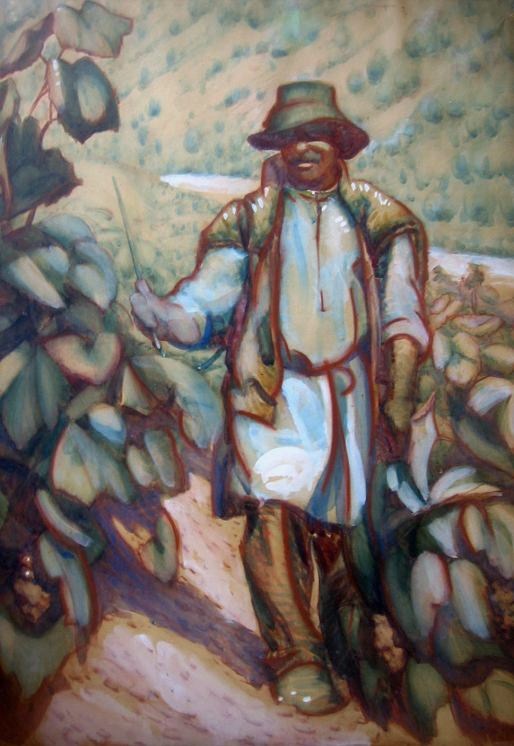GEORGE PICKEN
1898-1971
George Picken was a prominent painter among the American generation that matured between the world wars in the first half of this century. His sensibilities were shaped by urban immigrant realities, World War I and the depression, and his close relationships with friends and colleagues like Stuart Davis, Edward Hopper, Charles Burchfield, John Marin, Philip Evergood and Kuniyoshi. He also faced the wave of indifference felt by many of these artists as abstract expressionism captured the world's, and the critics' attention. However, Picken pursued his own artistic vision, even as he experimented with abstraction and color. In his last decade, he returned to figurative work and painted some of his most powerful work. The artist died in 1971 at the age of 73.
Picken was born in New York City in 1898, the son of a Scottish immigrant artist and photographer. He served in World War I with an ambulance corps that saw action at Verdun. He returned to France to live and work, drawing and painting on the left bank, absorbing the artistic culture of that vibrant period.
Back in New York, he studied at the Art Students League and married Viola Carton, a young beauty from Yonkers who was said to be one of Reginald Marsh's favorite models. The earliest canvases that survive have urban themes and a dark palette, which prompted Stuart Davis to ask him why he was always painting "dungeons." Picken had a difficult time during the depression, supporting a wife and two children, but was employed by the WPA. His murals can still be seen near Albany, at the Fort Edward and Hudson Falls post offices.
Picken's first real patron was Marie Harriman, the wife of railroad baron Averill Harriman. She gave him his first one-man shows. In the 1940's, an acquaintance with Edward Hopper led to Picken joining Hopper, Marsh, Burchfield et al at the prestigious Rehn Gallery on Madison Avenue. Picken would have regular one-man shows there until his death.
George Picken also became well known as a teacher. He taught painting, printmaking and lithography at Cooper Union and Columbia University for over 20 years.
His work is in the collections of the Whitney Museum of American Art, the Corcoran Gallery, the Newark Museum, the Berkshire Museum, the Ogunquit Museum an numerous other collections.
George Picken studied at the Art Students League in New York as well as in Paris, France. He was a member of The American Artists Congress; American Society of Painters, Sculptors, and Gravers; An American Group; American Association of University Professors; Federation of Modern Painters and Sculptors; "The Islanders"; National Society of Mural Painters; Society of American Graphic Artists; Society of Audubon Artists.
During his most creative and productive years while living in New York City he was among a very select stable of artists handled by the Frank Rehn Gallery. Those artists included Edward Hopper, Charles Burchfield, Alexander Brook, Henry Mattson, Reginald Marsh and other fine American artists.
In his earliest work, George Picken portrayed industrial and urban scenes in a realist style and dark palette characteristic of the Depression era. By the 1940s, he turned to rural landscapes inspired by the surroundings at his country home in the Berkshires. Located in southwestern Massachusetts, Bash-Bish Falls is one of the most spectacular natural sites in New England. The final cascade, seen here, drops 80 feet over boulders into the pool below. While the Falls were a favorite sketching spot of the Hudson River School, Picken uses a more expressive visual language than his predecessors. Employing vibrant colors and bold outlines, he transforms the landscape into large, simplified shapes to convey the mystical aspect of nature.
Although Picken turned away from realism in the 1950s to experiment with pure abstraction, he created a synthesis of the two during the 1960s and 70s.
George also taught at many distinguished institutions throughout his career, including:
Art Students League, New York, NY Hofstra University, Hempstead, NY
Columbia University, New York, NY Kansas City Art Institute, Kansas City, MO
Cooper Union, New York, NY Berkshire Museum, Pittsfield, MA
Brooklyn Museum School, Brooklyn, NY Hartford University, West Hartford, CT
After George's death his son David Picken arranged for Ronald Pisano to handle George's estate. When Ronald died David Picken took over the responsibilities of the art estate.
EXHIBITIONS
One-Man Exhibitions Group Exhibitions
Annuals & Biennials Public Collections
* 2005 Berkshire Museum, Pittsfield, Massachusetts
* 2001 Monique Goldstrom Gallery, New York, NY
* 1999, 2000 M B Modern, New York, NY
* 1999, 2000 D. Wigmore Fine Art, Inc., New York, NY
* 1971, 1967, 1963, 1960, 1954, 1952, 1949, 1947, 1945, 1942 Frank K.M. Rehn Galleries, New York, NY
* 1970 The Image Gallery, Stockbridge, MA
* 1970 Simon's Rock School, Great Barrington, MA
* 1970 St. Michael's College, Winooski, VT
* 1968 Grace Gallery, New York City Community College, Brooklyn, NY
* 1967, 1953, 1940 Berkshire Museum, Pittsfield, MA
* 1966 Gallery One, Hillsdale, NY
* 1966 Kansas City Art Institute, Kansas City, MO
* 1963 Rondo Gallery, Lenox, MA
* 1949 Cowie Galleries, Los Angeles, CA
* 1943 Kalamazoo Institute of Art, Kalamazoo, MI
* 1940, 1938, 1936, 1935 Marie Harriman Gallery, New York, NY
* 1932 Union College Library, Schnectady, NY
* 1932, 1928, 1924 The New York Public Library, New York, NY
* 1924 S.S. Carvalho Gallery, Plainfield, NJ
Source:
georgepicken.com with permission from David Picken, son of the artist
![Kunsthandel Henk van der Kamp - Internationale Kunsthandel [home link] Kunsthandel Henk van der Kamp - Internationale Kunsthandel [home link]](includes/templates/template_default/images/henkvanderkamp.gif)

